Introduction Of Eup And Myeon
- GAEJIN-MYEON(開津面)
-
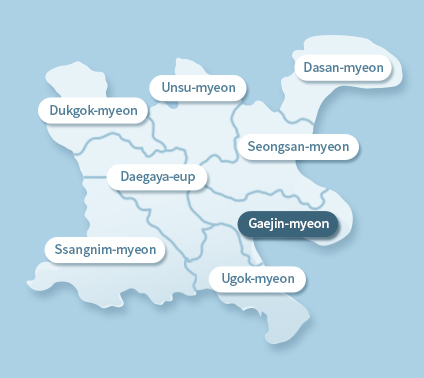
Gaejin-myeon is one of 8 eup in Goryeong-gun. As one of Goryeong-gun, it’s named Gugong-myeon(九谷面) after Gugok(九谷) and controlled 7 villages, such as Gaepo(開浦), Sirye(詩禮), Hanje(漢制), Osa(吾士), Gwangdo(廣道), Gugok(九谷), and Bongdong(鳳洞), however, while rearranging the gunmyeon in 1941, 6 dong from Songcheon-myeon(松泉面) such as Sinan(新安), Jikdong(直洞), Songcheon(松泉), Banun(盤雲), Yangjeon(良田), and Naedong(內洞) and 8 dong from former Hyeonpung-gun(玄風郡) Jinchon-myeon(津村面), such as Inan(仁安), Chisan(雉山), Baeksan(佰山), Jeoksan(笛山), Okdong(玉洞), Saengdong(省洞), Budong(釜洞), and Changdong(倉洞) were merged. It was named Gaejin-myeon(開津面) after the first word from Gaepo(開浦) and Jinchon(津村) and is controlling 11 dong; Gaepo, Osa, Gugok, Inan, Oksan, Saengdong, Buan, Sinan, Jikdong, Banun, and Yangjeon.
There’s Nongong-myeon, Dalseong-gun and Hyeonpung-myeon across the Nakdong-gang on the east, Ugok-myeon, Hyeonpung-myeon, and Guji-myeon, Dalseong-gun on the south, Goryeong-eup on the west and Seongsan-myeon on the north.
In May, 1988, dong was changed to ri until today.
- DASAN-MYEON(茶山面)
-
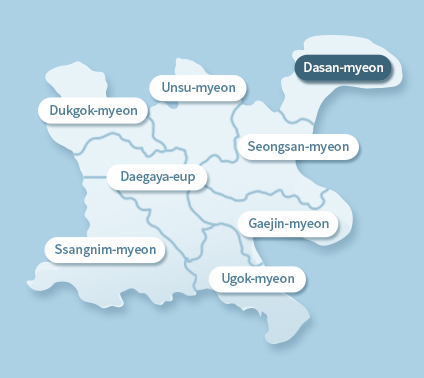
Dasan-myeon is originally Dasajihyeong(多斯只縣) or Dapjihyeon(沓只縣) as one of 8 eup in Goryeong-eup but it was changed to Habin-hyeon(河濱縣) during the 35th King Gyeongdeog(景德王) of Silla so it was Suchang-gun(壽昌郡) or Yeonghyeon(領縣) in Suseong(壽城) but at the 9th year of King Hyeonjong during the 8th generation of Goryeo (1019), Habin-hyeon(河濱縣) was changed to the current Hyeongnaedong(縣內洞), Habin-myeon, Dalseong-gun and it became part of Gyeongsan-bu(京山府 現星州). During Joseon Dynasty period, it was incorporated to Daegu-bu(大邱府) and then became Dagi-bang(茶基坊), Dasan-bang(茶山坊) or Beolji-bang(伐知坊) after transferring to Seongju and at the 10th year of Gwangmu by Gojong, it merged 10 dong from Dasan-myeon(茶山面); Gwagchon(藿村), Jinae(池內), Beopdong(法洞), Sindong(新洞), Sanggok(上谷), Jwahak(座鶴), Balsan(鉢山), Pyeongri(平里), Hochon(湖村), and Sachon(沙村); and 11 dong from Beolji-myeon(伐知面); Najeong(羅亭), Asi(阿時), Beolji(伐知), Dongam(東岩), Namchon(南村), and Samdong(三洞); and named Dasan-myeon and controlled 10 dong; Pyeongri, Jwahak, Sanggok, Hochon, Gwagchon, Wolseong, Najeong, Beolji, Songgok, and Nogok.
It was changed from dong(洞) to ri(里) in May 1, 1988 and there’s Hwawon-myeon, Dalseong-gun, Seongseo, Daegu across the Nakdong-gang on the east, Nongong-myeon, Okpo-myeon, Dalseong-gun across the Nakdong-gang on the south and Yongam-myeon, Seongju-gun, and Seongsan-myeon on the west and Dasa-myeon, and Habin-myeon Dalseong-gun on the north.
- DEOKGOK-MYEON(德谷面)
-
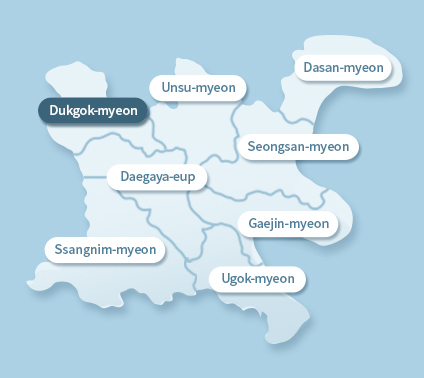 Deokgok-myeon is one of 8 eup in Goryeong-gun which was originally Seongju-gun(星州郡) but as mountainous area, it was called Akgong-myeon(岳谷面) but during the King Injo in Joseon period, Yunhwi(尹暉) was changed to Deokgok(德谷) and controlled 15 dongri, such as Sinyul(新栗), Gidong(奇童), Garyun(伽倫), Daegam(大監), Oro(五老), Simeo(尋漁), Myeonggok(明曲), Baekdong(白洞), Posang(浦上), Seongdong(聖洞), Dalli(達里), Danggye(唐溪), Gwangcheon(廣川), Singi(新基), and Yangji(陽地). During the 10 year of Gwangmu by King Gojong (1906), it was incorporated with Goryeong-gun and then according to the rearranging the gunmyeon in 1941, it merged with Jisa-dong(只士洞), Huam-dong(後岩洞) in Gwangdong-myeon(館洞面) and 13 dong in former Ingong-myeon, Seongju-gun 州郡 仁谷面), such as Banseong, Yangsan(良山), Daehyeong(大荊), Manha(晩霞), Bonri(本里), Jeonsang(田相), Okgye(玉溪), Mureung(武陵), Yedong, Jungheung, Yongheung, Jangam, and Ori and then renamed as Deokgok-myeon and was controlling 11 dong; Banseong(般城), Bonri(本里), Okgye(玉溪), Yedong(禮洞), Yongheung(龍興), Garyun(伽倫), Wonsong(元松), Nodong(老洞), Baekdong(白洞), Seongdong(聖洞), and Huam(後岩). In January 10, 1983, Seongdong(聖洞) 1 and 2 dong was incorporated into Suryun-myeon(修倫面), Seongju-gun and dong was changed to ri on May 1, 1988. There’s Unsu-myeon on the east, Goryeong-eup and Yaro-myeon, Hapcheon-gun, Gyeongsangnam-do on the south, Yaro-myeon, Gaya-myeon, Hapcheon-gu and Suryun-myeon, Seongju-gun on the west and Suryun-myeon, Seongju-gun on the north.
Deokgok-myeon is one of 8 eup in Goryeong-gun which was originally Seongju-gun(星州郡) but as mountainous area, it was called Akgong-myeon(岳谷面) but during the King Injo in Joseon period, Yunhwi(尹暉) was changed to Deokgok(德谷) and controlled 15 dongri, such as Sinyul(新栗), Gidong(奇童), Garyun(伽倫), Daegam(大監), Oro(五老), Simeo(尋漁), Myeonggok(明曲), Baekdong(白洞), Posang(浦上), Seongdong(聖洞), Dalli(達里), Danggye(唐溪), Gwangcheon(廣川), Singi(新基), and Yangji(陽地). During the 10 year of Gwangmu by King Gojong (1906), it was incorporated with Goryeong-gun and then according to the rearranging the gunmyeon in 1941, it merged with Jisa-dong(只士洞), Huam-dong(後岩洞) in Gwangdong-myeon(館洞面) and 13 dong in former Ingong-myeon, Seongju-gun 州郡 仁谷面), such as Banseong, Yangsan(良山), Daehyeong(大荊), Manha(晩霞), Bonri(本里), Jeonsang(田相), Okgye(玉溪), Mureung(武陵), Yedong, Jungheung, Yongheung, Jangam, and Ori and then renamed as Deokgok-myeon and was controlling 11 dong; Banseong(般城), Bonri(本里), Okgye(玉溪), Yedong(禮洞), Yongheung(龍興), Garyun(伽倫), Wonsong(元松), Nodong(老洞), Baekdong(白洞), Seongdong(聖洞), and Huam(後岩). In January 10, 1983, Seongdong(聖洞) 1 and 2 dong was incorporated into Suryun-myeon(修倫面), Seongju-gun and dong was changed to ri on May 1, 1988. There’s Unsu-myeon on the east, Goryeong-eup and Yaro-myeon, Hapcheon-gun, Gyeongsangnam-do on the south, Yaro-myeon, Gaya-myeon, Hapcheon-gu and Suryun-myeon, Seongju-gun on the west and Suryun-myeon, Seongju-gun on the north.
- DAEGAYA-EUP(大加倻邑)
-
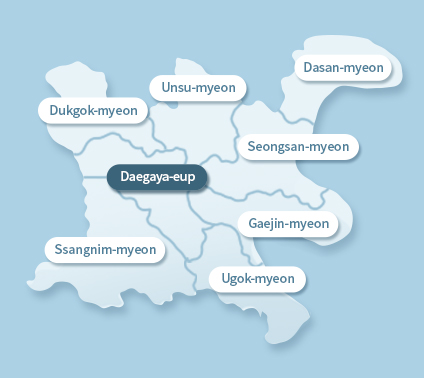
One of 8 myeon in Goryeong-gun. As the original location of Goryeong-gun, it was named Eumnae-myeon(邑內面), which controlled 14 dong; Kwaebin, Jeongdong, Heonmun, Janggi, Goa, Yeonjo, Dongbu, Bongdu, Junghwa, Sanghwa, Jisan, Wolgi, Makgok, and Singi. After rearranging the gunmyeon in 1941, it merged 7 dong from Naegong-myeon(乃谷面); Naesang(內上), Dongchon(東村), Sindong(新洞), Saneum(山陰), Radong(羅洞), Jeojeon(楮田), and Sinjeon(薪田); 2 dong from Gwangdong-myeon(舘洞面); Bongwan(本舘), and Oksan(玉山); and 4 dong from Ilyang-myeon(一良面); Naegok(內谷), Sugok(首谷), Oedong(外洞), and Jungdong(中洞); and named Goryeong-myeon(高靈面) after Goryeong-gun and controlled 13 dong; Kwaebin(快賓), Heonmun(軒門), Janggi(場基), Goa(古衙), Yeonjo(延詔), Junghwa(中化), Jisan(池山), Naesang(內上), Sindong(新洞), Jeojeon(楮田), Bongwan(本舘), Naegok(內谷), and Oedong(外洞).
According to the rule No. 9409 by the president in May 1, 1979, it became Daegaya-eup(大加倻邑). There’s Seongsan-myeon(星山面), Gaejin-myeon(開津面), and Ugok-myeon(牛谷面) on the east, Ugok-myeon and Ssangnim-myeon on the south, Ssangnim-myeon and Yaro-myeon from Hapcheon-gun, Gyeongsangnam-do on the south and Deokgok-myeon and Unsu-myeon on the north. It was changed from dong to ri on May 1, 1988.
- SEONGSAN-MYEON(星山面)
-
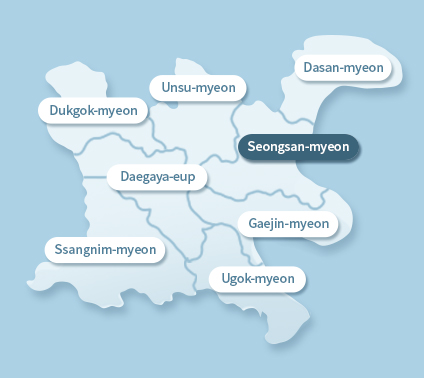 As one of 8 myeon in Goseong-gun, it was Ili-hyeon(一利縣) in Silla but it was changed to Seongsan-gun(星山郡) during the 35th of King Gyeongdeog and then to Gai-hyeon(加利縣) during the early Goryeo dynasty and then affiliated as Seongju-mok(星州牧) during the 8th King Hyeonjong and then became Gahyeon-myeon in the middle of Joseon and controlled 13 dongri; Mugye(茂溪), Yulli(栗利), Bakgok(朴谷), Daeheung(大興), Sinchon(新村), Yangdong(陽動), Yongso(龍沼), Wolsan(月山), Sangyong(上龍), Daeyong(大龍), Gangjeong(江亭), and Hyeonggok(兄谷). It was incorporated into Goryeong-gun on the 10th year of Gwangmu by King Gojong, which was 1906 and then during the rearranging the gunmyeon in 1941, it merged 3 dongri out of 11 dongri from Soya-myeon(所也面), Seongju-gun; Gijok(期足), Deukgok(得谷), Gogok(高谷), Bonggok(鳳谷), Samdae(三大), Banjang(班庄), Deoksan(德山), Ugok(牛谷), Jindu(津頭), and Yonggok(龍谷); and 3 dongri from Dojang-myeon(道長面) such as Gisan(箕山), Jigyeong(只境), and Gijok(旗足) and 4 dongri from Gueum-myeon(九音面), Goryeong-gun, such as Sabu(沙鳧), Doyeong(道嶺), Punggok(風谷), and Sinchon(新村). I twas named Seongsan-myeon after Seongsan-gun(星山郡) during Silla and controlled 14 dong; Gijok, Deukseong, Eogok, Gotan, Samdae, Ogok, Mugye, Bakgok, Daeheung, Yongso, Sangryong, Gangjeong, Sabu, and Gisan. There’s Nongong-myeon, Dalseong-gun across the Nakdong-gang on the east, Gaejin-myeon on the south, Unsu-myeon and Goryeong-eup on the north and some of Dasan-myeon and Yongam-myeon, Seongju-gun on the north. It was chanrged from dong to ri on May 1, 1988 until now.
As one of 8 myeon in Goseong-gun, it was Ili-hyeon(一利縣) in Silla but it was changed to Seongsan-gun(星山郡) during the 35th of King Gyeongdeog and then to Gai-hyeon(加利縣) during the early Goryeo dynasty and then affiliated as Seongju-mok(星州牧) during the 8th King Hyeonjong and then became Gahyeon-myeon in the middle of Joseon and controlled 13 dongri; Mugye(茂溪), Yulli(栗利), Bakgok(朴谷), Daeheung(大興), Sinchon(新村), Yangdong(陽動), Yongso(龍沼), Wolsan(月山), Sangyong(上龍), Daeyong(大龍), Gangjeong(江亭), and Hyeonggok(兄谷). It was incorporated into Goryeong-gun on the 10th year of Gwangmu by King Gojong, which was 1906 and then during the rearranging the gunmyeon in 1941, it merged 3 dongri out of 11 dongri from Soya-myeon(所也面), Seongju-gun; Gijok(期足), Deukgok(得谷), Gogok(高谷), Bonggok(鳳谷), Samdae(三大), Banjang(班庄), Deoksan(德山), Ugok(牛谷), Jindu(津頭), and Yonggok(龍谷); and 3 dongri from Dojang-myeon(道長面) such as Gisan(箕山), Jigyeong(只境), and Gijok(旗足) and 4 dongri from Gueum-myeon(九音面), Goryeong-gun, such as Sabu(沙鳧), Doyeong(道嶺), Punggok(風谷), and Sinchon(新村). I twas named Seongsan-myeon after Seongsan-gun(星山郡) during Silla and controlled 14 dong; Gijok, Deukseong, Eogok, Gotan, Samdae, Ogok, Mugye, Bakgok, Daeheung, Yongso, Sangryong, Gangjeong, Sabu, and Gisan. There’s Nongong-myeon, Dalseong-gun across the Nakdong-gang on the east, Gaejin-myeon on the south, Unsu-myeon and Goryeong-eup on the north and some of Dasan-myeon and Yongam-myeon, Seongju-gun on the north. It was chanrged from dong to ri on May 1, 1988 until now.
- SSANGNIM-MYEON(雙林面)
-
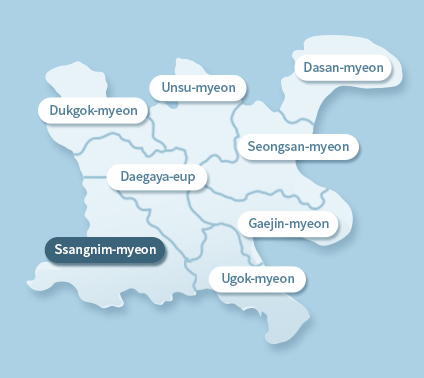
As one of 8 myeon in Goseong-gun, it was called Ssangdong-myeon(雙洞面) after merging 10 dong from Sangdong-myeon(上洞面) such as Hageo(下車), Gugo(九皐), Deokgok(德谷), Sanju(山州), Seoksa(石寺), Burye(扶禮), Eodong(漁洞), Songjeong(松亭), Baeksan(栢山), and Sinchon(新村) and 9 dong from Hadong-myeon, such as Gwiwon(貴院), Songnim(松林), Maechon(梅村), Sangga(上伽), Haga(下伽), Sandang(山塘), Chogok(草谷) and rearranged to 9 dong; Hageo, Sanju, Sinchon, Baeksan, Gwiwon, Songnim, Maechon, Hapga, and Sandang. 4 dong from Yucheon-myeon(鍮泉面); Pyeongji(平地), Anhwa(安和), Gabu(加富), and Bakgok(朴谷); and 3 dong from Anrim-myeon(安林面); Allim(安林), Dongbu(東部), and Seobu(西部);
Yucheon-myeon(鍮泉面)의 Pyeongji(平地), Anhwa(安和), Gabu(加富), and 9 dong from Gogok-myeon(高谷面); Wolmak(月幕), Yongdong(龍洞), Sanmak(山幕), Gukjeon(菊田), Banryong(般龍), Gogok(高谷), Jukseong(竹城), Childong(七洞), Sinchon(新村); were merged and named Imcheon-myeon(林川面) which was rearranged to 7 dong; Pyeongji, Anhwa, Bakgok, Allim, Wolmak, Yongdong, and Gogok. After the reorganization of administrative districts in 1930, Ssangdong-myeon(雙洞面) and Imcheon-myeon(林川面) were merged and it was named Ssangnim-myeon(雙林面) after the first words of previous two myeon.
The area is in a shape of triangle and there’s Goryeong-myeon and Ugok-myeon on the east, Deokgok-myeon, Hapcheon-gun, Gyeongsangnam-do and Yulgok-myeon and Ssangchaek-myeon on the south, Myosa-myeon and Yaro-myeon, Hapcheon-gun in west and Goryeong-eup on the north.
- UGOK-MYEON(牛谷面)
-
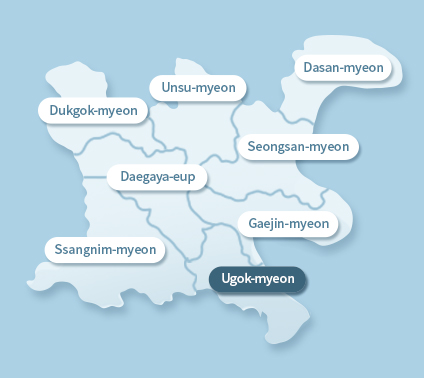
One of 8 myeon in Goryeong-gun. Originally, it was Hami-myeon(下彌面), Goryeong-gun which managed 11 dongri; Dojin(挑津), Sabu(沙鳧), Jeodong(楮洞), Daegok(大谷), Ara(阿羅), Woro(月塢), Yeondong(蓮洞), Asan(阿山), Podong(扶洞), Budong(釜洞), and Sadeung(沙嶝); but after rearranging the gunmyeon in 1941, it merged 5 dongri of Uchon-myeon(牛村面); Sachon(沙村), Hwangseong(黃城), Yajeong(野亭), Agok(阿谷), and Sokdong(涑洞); 4 dongri of former Dapgong-myeon(沓谷面), Hyeonpung-gun(玄風郡); Joji(鳥枝), Dapgok(沓谷), Huigok(希谷), and Agok(阿谷); and 3 dongri of Wangji-myeon(旺旨面); Podong(浦洞), Hudong(後洞), and Gaekji(客基). It’s named Ugok-myeon after Uchon and Dapgok and is controlling 13 dongri; Dojin, Yegok, Dapgok, Joji, Podong, Gaekji, Yeondong, Woro, Daegok, Sajeon, Yajeon, Sokdong, and Sachon.
There’s Guji-myeon, Dalseong-gun across the Nakdong-gang on the east, Guji-myeon, Dalseong-gun, Ibang-myeon and Deokgok-myeon, Hapcheon-gun of Gyeongsangnam-do on the south, Goryeong-eup, Ssangnim-myeon, Goryeong-gun on the west and Gaejin-myeon on the north. On February 15, 1983, Joji-dong was renamed as Bongsan-dong(鳳山洞) and dong was changed to ri in May 1, 1988.
- UNSU-MYEON(雲水面)
-
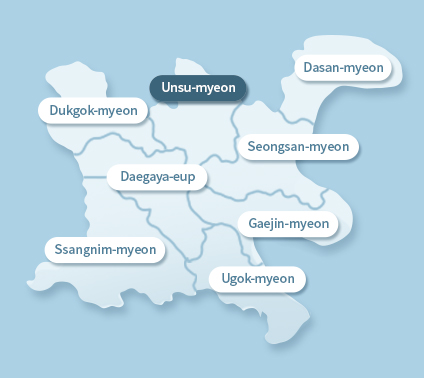 One of 8 myeon in Goryeong-gun. Originally, it’s one of Goryeong-gun but it was named Ulna-myeon after Unra-san(雲羅山) as an area of Seongju-gun(星州郡). It originally controlled 6 villages; Unsan, Wolseong, Beomam, Geoho-dong, Oehwa, and Geumseong but it was transferred to Goryeong-gun on 10th year of Gwangmu by King Gojong (1906) and according to the rearranging the gunmyeon in 1941, it merged 2 dongri of Gueum-myeon(九音面); Unsan(雲山) and Samha(三河); 9 dongri of Heuksu-myeon(黑水面), Seongju-gun such as Daeseong(大成), Naeseong(內成), Pyeongchon(坪村), Oepyeong(外坪), Oesin(外新), Yeonbong(延鳳), Singung(新弓), Bonggye(鳳溪), and Mulhan(勿閑), and 7 dongri of Dojang-myeon(道長面); Beopdong(法洞), Yeonbong(延鳳), Baekjeon(栢田), Ipsan(入山), Yudong(柳洞), Gaeryeon(開蓮), Goseung(高勝) and named Unsu-myeon after Unra(雲羅) and Heuksu(黑水) and is controlling 9 dongs; Wolsan(月山), Hwaam(花岩), Bongpyeong(鳳坪), Daepyeong(大坪), Singan(新間), Unsan(雲山), Beopdong(法洞), Ipsan(入山), and Yudong(柳洞). There’s Seongsan-myeon on the east, some of Seongsan-myeon and Goryeong-gun on the south, Deokgok-myeon and Suryun-myeon from Seongju-gun on the south; and Yongam-myeon of Dalseong-gun on the north.
One of 8 myeon in Goryeong-gun. Originally, it’s one of Goryeong-gun but it was named Ulna-myeon after Unra-san(雲羅山) as an area of Seongju-gun(星州郡). It originally controlled 6 villages; Unsan, Wolseong, Beomam, Geoho-dong, Oehwa, and Geumseong but it was transferred to Goryeong-gun on 10th year of Gwangmu by King Gojong (1906) and according to the rearranging the gunmyeon in 1941, it merged 2 dongri of Gueum-myeon(九音面); Unsan(雲山) and Samha(三河); 9 dongri of Heuksu-myeon(黑水面), Seongju-gun such as Daeseong(大成), Naeseong(內成), Pyeongchon(坪村), Oepyeong(外坪), Oesin(外新), Yeonbong(延鳳), Singung(新弓), Bonggye(鳳溪), and Mulhan(勿閑), and 7 dongri of Dojang-myeon(道長面); Beopdong(法洞), Yeonbong(延鳳), Baekjeon(栢田), Ipsan(入山), Yudong(柳洞), Gaeryeon(開蓮), Goseung(高勝) and named Unsu-myeon after Unra(雲羅) and Heuksu(黑水) and is controlling 9 dongs; Wolsan(月山), Hwaam(花岩), Bongpyeong(鳳坪), Daepyeong(大坪), Singan(新間), Unsan(雲山), Beopdong(法洞), Ipsan(入山), and Yudong(柳洞). There’s Seongsan-myeon on the east, some of Seongsan-myeon and Goryeong-gun on the south, Deokgok-myeon and Suryun-myeon from Seongju-gun on the south; and Yongam-myeon of Dalseong-gun on the north.